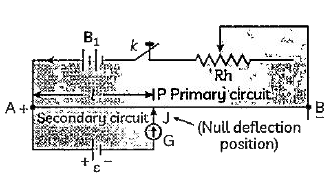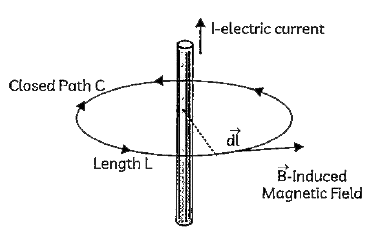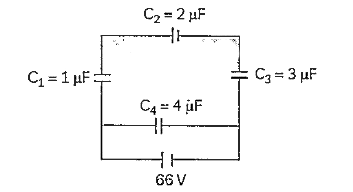In a plane perpendicular to the magnetic meridian, the dip needle will be:
verticle
inclined equal to the angle of dip at that place
horizontal
pointing in any direction
The correct Answer is:D
To solve the question regarding the behavior of a dip needle in a plane perpendicular to the magnetic meridian, we need to understand the concepts of magnetic meridian and magnetic dip.
1. Understanding Magnetic Meridian: The magnetic meridian is a vertical plane that contains the magnetic field lines of the Earth. It is defined by the direction of the magnetic north and south poles.
2. Defining the Dip Needle: A dip needle is a magnetized needle that can rotate freely in a vertical plane. It aligns itself with the Earth's magnetic field.
3. Plane Perpendicular to Magnetic Meridian: When we say a plane is perpendicular to the magnetic meridian, it means that the plane is oriented in such a way that it does not align with the magnetic field lines of the Earth.
4. Behavior of the Dip Needle: In a plane that is perpendicular to the magnetic meridian, the dip needle will not align itself vertically (which is the case when it is in the magnetic meridian). Instead, it will experience a torque due to the magnetic field.
5. Resulting Position of the Dip Needle: The dip needle will tend to align itself in the direction of the horizontal component of the Earth's magnetic field. This means that it will point towards the magnetic north but will also dip at an angle relative to the horizontal plane.
6. Conclusion: Therefore, in a plane perpendicular to the magnetic meridian, the dip needle will not be vertical but will point towards the magnetic north while dipping at an angle.
Final Answer:
In a plane perpendicular to the magnetic meridian, the dip needle will point towards the magnetic north but will dip at an angle relative to the horizontal.
---
In a plane perpendicular to the magnetic meridian, the dip needle will point towards the magnetic north but will dip at an angle relative to the horizontal.
Topper's Solved these Questions
- SAMPLE PAPER 7BOOK - EDUCART PUBLICATIONCHAPTER - SAMPLE PAPER 7EXERCISE - SECTION-C
6 Videos
- SAMPLE PAPER 7BOOK - EDUCART PUBLICATIONCHAPTER - SAMPLE PAPER 7EXERCISE - SECTION-C
6 Videos
- SAMPLE PAPER 6BOOK - EDUCART PUBLICATIONCHAPTER - SAMPLE PAPER 6EXERCISE - Section-C
6 Videos
- SAMPLE PAPER 9 BOOK - EDUCART PUBLICATIONCHAPTER - SAMPLE PAPER 9 EXERCISE - SECTION - C
3 Videos
Similar Questions

The null point of a potentiometer is at 56 cm with standard cell of 1.02 V. If the null point is at 70 cm, the value of another cell is:
View Solution
The null point of a potentiometer is at 56 cm with standard cell of 1.02 V. If the null point is at 70 cm, the value of another cell is:
View Solution
If two conductors carry current in opposite direction, then:
View SolutionIn the given figure charge on capacitor C2 is:

View SolutionA dip circle is taken to geomagnetic equator. The needle is allowed to move in a vertical plane perpendicular to the magnetic meridian. The needle will stay
View SolutionA dip needle in a plane perpendicular to magnetic meridian will remain
View SolutionThe dip at a place is delta. For measuring it, the axis of the dip needle is perpendicular to the magnetic meridian. If the axis of the dip needle makes angle θ with the magnetic meridian, the apparent dip will be given tanδ1 which is equal to:
View Solutionचुम्बकीय याम्योत्तर के लम्बवत् तल में नति सुई (dip needle)-
View SolutionA dip needle arranged to move freely in the magnetic meridian dips by an angle θ. The vertical plane in which the needle moves is now rotated through an angle α from the magnetic meridian. Through what angle the needle will dip in the new position?
View SolutionA dip needle in a plane perpendicular to magnetic meridian will remain
View SolutionThe vertical plane dip circle is perpendicular to the magnetic meridian. The dip needle reads
View SolutionA dip circle is taken to geomagnetic equator. The needle is allowed to move in a vertical plane perpendicular to the magnetic meridian. The needle will stay
View SolutionThe dip at a place is delta. For measuring it, the axis of the dip needle is perpendicular to the magnetic meridian. If the axis of the dip needle makes angle theta with the magnetic meridian, the apparent dip will be given tan delta_(1) which is equal to:
View SolutionA dip circle is placed perpendicular to the magnetic meridian then thte magnetic needle will aligh
View SolutionA dip circle is taken to geomagnetic equator. The needle is allowed to move in a vertical plane perpendicular to the magnetic meridian. The needle will stay
View SolutionThe dip at a place is delta . For measuring it, the axis of the dip needle is perpendicular to the magnetic meridian. If the axis of the dip needle makes angle theta with the magnetic meridian, the apparent dip will be given by tan delta_1 =
View Solution

